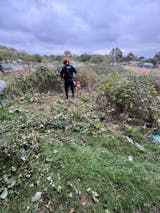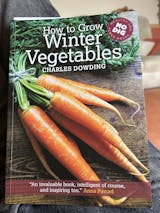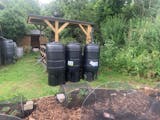My advice on managing slugs
Snails are slugs with a shell, and both are molluscs. They need moisture around them to survive and thrive, and in dry summer conditions they live deeper in the soil, even for long periods.
- If summer is moist, the warm conditions see more slug activity, larger ones especially. They do a lot of eating in the summer months.
- In winter slugs are less busy, often hibernating deep down away from any frost.
- They may be a problem when winter is mild, enabling them to carry on eating and breeding, especially small grey slugs.



Remedies
TOP TIP: Rely on good husbandry to prevent damage, rather than using products to ‘cure’ a problem.
The best remedies come from understanding what slugs are about: what is their role in nature? I see them as recycling agents who eat and and excrete old leaves, which are no longer useful to plants. Slugs convert redundant leaf material into food for new growth. Looked at this way, slugs are a great asset and can be seen as mini compost heaps, working their way around our plants.
If only it was always like this! Nonetheless, it’s an understanding that enables our gardens to contain fewer slugs, by reducing their likely food choices.

Prevention
A key strategy is to minimise their habitat, which means being tidy, especially close to susceptible plants. For example, lettuce, and almost all seedlings with just two leaves, especially carrots just germinating. The tiny leaves are often eaten before you see them. Likewise dwarf French beans, which are weak in cool conditions, and any plants sown out of season. Their growth is not strong and slugs sense this.


Slug pellets
These cause many more problems than they solve.
Firstly, they contain poisons that harm other soil life, which are even in the so-called ‘organic’ slug pellets. The main ingredient in these ‘organic’ slug pellets is ferric phosphate, which is toxic to birds and small animals.
Their chelating or binding agent is EDTA, which was researched by Dr Kathy Lewis of the Agriculture and Environment Research unit at the University of Hertfordshire, UK. She discovered that it is toxic to earthworms.
The metaldehyde in blue, chemical pellets is toxic to mammals and birds. Yet on allotment sites, I have commonly seen the soil surface literally blue with so many pellets. This is environmental destruction.
Ways to reduce slug numbers
TOP TIP: Open space around your plantings means that slugs are less likely in the vicinity of your plants. Make beds for vegetables as far as possible from hedges, bushy shrubs, weedy edges and dry stone walls.
No dig helps in two emphatic ways:
- Soil left undisturbed allows slug predators, such as toads and beetles, more chances to maintain or increase their numbers. Carob and Common Ground beetles can eat a lot of slug eggs and baby slugs.
- No dig results in soil with decent aeration. In contrast, after digging there can be layers of damaged and compacted soil, where fermentation occurs in the anaerobic conditions. One result is production in the soil of alcohol, in other words mini slug pubs, which attract them. I learnt this from Professor Elaine Ingham.



You can water less often, say every 3 to 4 days instead of every day, to reduce slug populations at surface level. This is a result of the soil/compost surface drying out between waterings, creating a less usable habitat for mollusks.
In a similar vein, as plants grow, their lower leaves start to yellow and even look diseased. If allowed to fall, they attract slugs and give them a damp home.
Instead, remove them by pushing downward on the stalks, or twisting them off. It’s safe to put them on the compost heap. A further benefit is that while tidying plants, you can spot and pull any weeds.
If slugs are rampaging, in damp summer weather especially, venture to the garden at dusk. You will be amazed at the wildlife you see, not least slugs and snails. Gather them up or cut them, to reduce population levels.
Vegetables susceptible to slug damage
Commonly one sees damage to carrot seedlings, celery, Chinese cabbage and pak choi.
For other vegetables, damage is possible, but is usually less likely and less severe.
Ways to minimise the likelihood of damage:
- Sow carrots in a bed where there is no overhanging vegetation, no mulch of undecomposed material such as straw of fibrous digestate, and no old and rotting wood sides to beds.
- Slugs like celery, so start seedlings under cover, then grow them in a clear, open space, with minimal habitat for molluscs. Woodlice and slugs can tunnel into celeriac, so beds without wooden sides give best results.
- Chinese cabbage and pak choi are highly susceptible to slug damage. Every winter I grow polytunnels full of lettuce, spinach, mizuna and salad rocket, with no slug holes. But if there are Chinese cabbage or pak choi among these plants, they have many holes, and we find small grey slugs while picking the leaves.


See the videos in my Pests and Diseases YouTube playlist for more information on slugs and other pests, and my Pests knowledge pack.












































